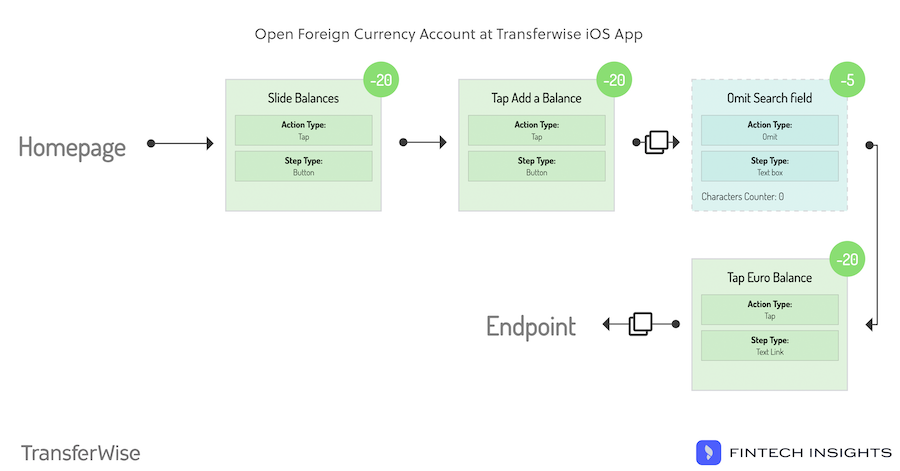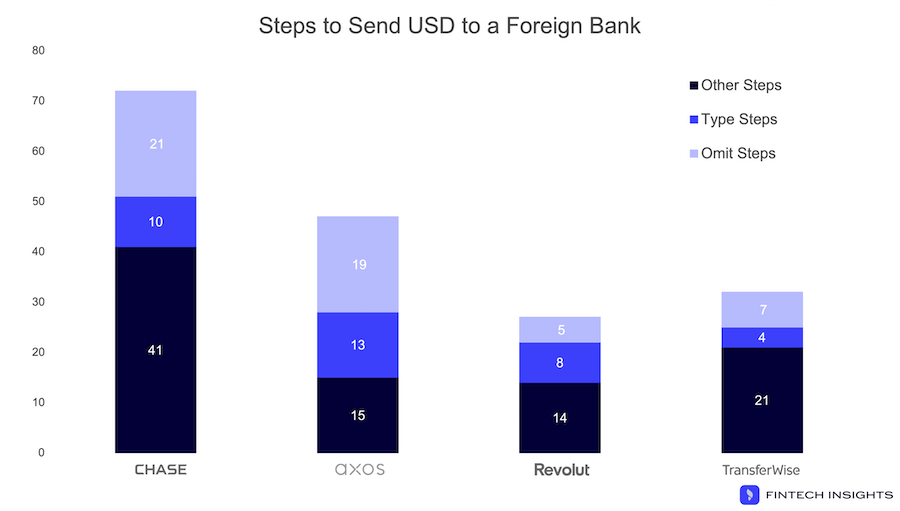The US market: are EU-based challengers coming to rustle up some feathers?
COVID-19’s ongoing impact on the world has certainly influenced the position of a number of challenger banks in the US market, which are taking bigger and bigger shares in customer use everyday.
While traditional banks are trying to keep up with the increased rate of US-based challenger banks expanding their digital banking possibilities, EU-based challengers are slowly but steadily crossing over the pond to get their share.
To better understand how the market is steadily being reshaped, we chose to analyse four different scenarios each representing a digital banking functionality that is increasingly becoming popular among users.
For this article, we will investigate which US banks offer currency exchange in a bank account, USD transfers in international accounts, investment options and virtual card payments after a customer has blocked a compromised card. Specifically, we will be taking into account and measuring their iOS capabilities.
Data source
To conduct this research, the data were taken from Fintech Insights, a product of Scientia. Fintech Insights is a digital banking research platform, where all features provided by a bank throughout their digital channels are analysed, measured and listed in personalised charts.
Each digital banking function is analysed, UX evaluated and captured in helpful “how they do it” videos.
Why did we choose the four scenarios?
With the pandemic accelerating the need for banking digitalisation and an era of renewed outwardness ahead in the US, it’s becoming more and more evident that this should be reflected in customers’ everyday banking. Being able to participate in an open digital market simply by holding and managing different currencies is surely representative of that.
This inherent outwardness is also seen in the billions of USD transferred every year to accounts outside of the US. This, however, is primarily executed through a third provider like Paypal, WesternUnion, and less so through a single US bank account. Whether a customer needs to send to a student studying abroad their monthly allowance or money to a family member from a US account to a foreign account, the need remains to be dominant.
The third scenario was introduced as an answer to the growing customer interest in investments. What the recent Gamestop story has definitely proven is that investments are no longer a specialist matter. This increased interest over the years almost necessitates the need for the incorporation of wealth management features into a bank’s digital capabilities.
Finally, the higher than expected increase in e-commerce sales due to shops shutting down inevitably brought about a rise in online fraud. Customers going through their transactions and discovering a transfer that has not been authorised has become extremely common these days. They must be able to react quickly to defend themselves, block their card, order another but be able to go shopping the same day and pay. Therefore, we decided to include a scenario focused on that feature.
Scenarios
Scenario 1: You have a bank account with USD as the primary currency. You want to be able to hold different currencies and exchange between them.
For newly-released in the US market Revolut, the User Journey to open a new currency is completed swiftly with the option of a multi-currency account. After a customer logs into their banking application, they are immediately presented with their account. Tapping on the primary currency they are given the choice to change between currencies or open a new currency into their account. From there, exchanging money between currencies is as simple as clicking the buying and selling buttons and typing in their desired amount to be exchanged.
TransferWise offers that feature by utilising multiple separate accounts, Balances. Instead of opening a single account that holds different currencies, customers have to create a unique account for each new currency. As can be seen in the steps flowchart above, again simplicity is key here. Customers log in, head to their accounts, here named Balances, swipe left and tap to open a new Balance in the currency of their choice. To switch between currencies, they have to swipe left or right, and select to exchange between currencies by clicking on the relevant button.
Unfortunately, the data extracted from FinTech Insights does not indicate other US traditional banks or challengers offering this feature yet.
Scenario 2: You have a bank account and want to send USD to your extended family in five different countries.
Our research into iOS capabilities showed that only two traditional banks in the US provide customers with the capability of sending money through an interbank transaction: Chase and Axos Bank.
Chase customers to fulfill this scenario will have to go through a process of 72 steps* omitting several information (COVID-19 updates, today’s snapshots), verifying, typing information (activation code, destination bank account details, recipient’s details), reading the transaction agreement, and even contacting customer support for an activation code.
Alternatively, the customer’s User Journey for this scenario for Axos Bank takes 47 steps (25 steps less than Chase), as is evident from the above graph. Again several information needs to be omitted, typed in (purpose of transaction, recipient’s and destination bank’s address details) and read. The process, as with Chase, includes inputting a verification code for the transaction.
TranferWise is the only US-based challenger that offers this feature. The bank’s users can complete this scenario in 32 steps. Steps include choosing currency to send, typing in (recipient’s details, amount of money), omitting information (recipient’s email, transaction reference), selecting Balance and reviewing information before accepting. Even though, as with the above banks, a final authorisation is required, the transaction is verified through inputting the user’s preferred method of logging into the application. It should be mentioned here that according to which country a customer sends money, a few extra steps might be added or deducted.
On the other hand, Revolut customers are able to send funds internationally to any currency supported by the bank in just 27 steps. After choosing a currency, customers only need to type in the bank account number, account details and the amount to be sent. Like Transferwise, a final approval by means of your preferred method of logging in will be required.
*Steps can be active and passive. Examples of active steps include tapping, typing, swiping, while passive steps are reading, omitting information etc.
Scenario 3: You just received a bonus at work for being employee of the year. You heard that a particular cryptocurrency/stock is on the rise and you want to get on into the action. Which bank can help you quickly open an account and buy cryptocurrency/stock?
Stock shares
Flowchart of buying a stock share via SoFi’s app:
The banks that, according to our FinTech Insights data, allow customers to open an investment account online, have an overview and/or buy and sell Stock shares through their iOS channels are SoFi, BoFA, Ally, Aspiration, Stash and MoneyLion and Axos Bank.
Even though Huntington, PNC, Citibank and Suntrust offer digital wealth management options, all of which are analysed by FinTech Insights, we chose not to include them in this analysis as customers are unable to open an investment account online. Huntington and PNC require customers to visit a local branch to activate this feature. Citibank and Suntrust customers have to make a phone call to the bank’s financial advisor to activate a brokerage account.
On the same note, it should be added that while Axos Bank allows for an online investment account opening, the process takes an average of one month to be completed before a customer can begin managing their Stock shares online.
Of the banks that a customer can open an account online, customers can buy whole Stock shares, manage them and sell them through their application in SoFI (the process for buying a stock shown in the above flowchart), BoFA, Ally and Axos Bank. Aspiration offers only the purchasing and selling of fractional Stock shares. Through Stash, customers can buy fractional Stock Shares and ETFs, while MoneyLion has only listed ETFs to buy and sell.
It is worth noting that of these banks, Sofi offers 27 unique stock management features, followed very closely by Ally with 23 and Stash with 20.
Cryptocurrencies
SoFi flowchart for buying cryptocurrency:
Our research showed that Revolut and SoFi are the only two US banks through which customers can buy and/or sell cryptocurrencies. The buying process is a relatively quick one for both banks with just 25 steps to each (as illustrated above in the flowchart above).
Scenario 4: You’ve seen a suspicious transaction in your account. How can you block your card, issue a new one but be able to go and pay for your groceries that day?
The following US banks complete our last scenario: MoneyLion, Current, Aspiration, TransferWise and Revolut. With all these digital banking providers, customers can, after noticing a transaction that wasn’t authorised, block their cards and apply for a new one. However, where we see these banks really differentiate from one another is how they handle their customers’ need to be able to pay the same day they blocked a card.
Current and Aspiration customers can use the virtual cards that were provided when they first opened their account. MoneyLion users will be given an interim virtual card, until their debit card arrives. For all three banks, their virtual cards can be added to Apple Pay.
TransferWise customers can immediately add their new debit card information to Apple pay, even if it has not yet been delivered.
Revolut customers can both use their already issued virtual card as well as add their newly-ordered card, that has yes to arrive, in the Apple Pay.
Afterthoughts
What clearly stands out from the all four specific scenarios is EU challenger Revolut’s standing in the US market as a leader in providing a User Journey to all the scenarios included. TransferWise comes a close second completing three of the scenarios. Aspiration, Axos Bank, MoneyLion offer two of the four features each, while Chase, SoFI, BoFa, Ally, Stash and Current one each.
Our research shows that traditional banks and credit unions seem to be lacking behind in offering these features that reflect real customer needs (offering one or two). It is also evident that when they offer some of the features examined they do so in a less efficient and more timely way for the customer. US-based challengers appear to have a similar position with traditional banks and, again fulfilling one or two of the scenarios, with the exception of TransferWise.
Even if Revolut seems to be ahead of these banks, our vast collection of data in FinTech Insights suggests that there are still features that the EU challenger does not support. A noticeable example can be found in our third scenario, where Revolut is not included in the collection of banks that offer stock share management in the US market.
These four different scenarios represent different aspects of important user needs. What our data-driven study clearly demonstrates is that there are market gaps regarding digital offerings that customers crave for. Traditional banks, credit unions and challengers need to react fast to be the first to explore these gaps and become the customers’ primary bank. They need to implement features that their customers need or else they run the risk of becoming obsolete.
We are constantly coming up with new scenarios and updating our list of over 300 unique User Journeys with new ones. If you need more specific scenarios on what US banks offer their customers and a large database with over 30,000 User Journeys on all US banks, challengers and credit unions, just sign up for a free demo of FinTech Insights.
By Alexandros C. Argyriou, CEO of Scientia
Alexandros C. Argyriou is CEO of Scientia and has been a fintech specialist for the digital transformation of the largest banks and financial institutions worldwide.
He and the Scientia team help banks bring their digital banking aspirations into fruition by designing products and services customers really desire.


















































